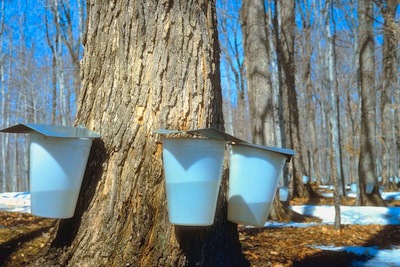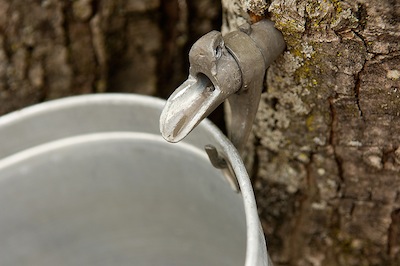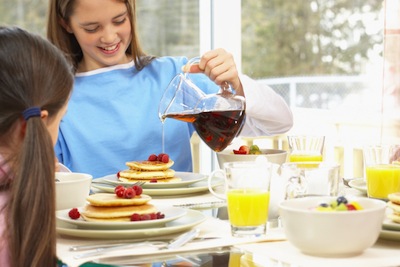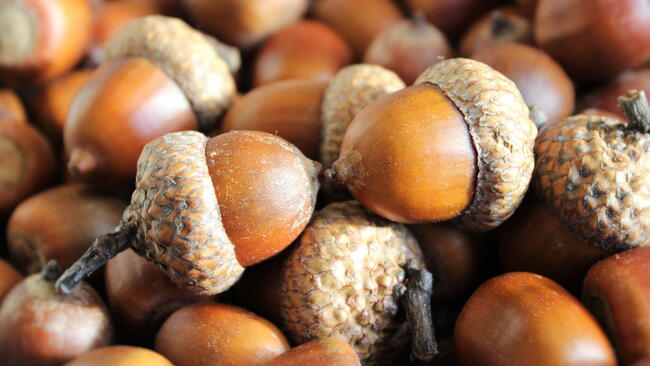Generally speaking, maple sugaring usually starts in late February or early March. How many maple trees does it take to make a gallon of syrup? How long does it take to fill a bucket with maple sap? What are maple syrup health benefits? Discover nature’s liquid gold!
The Old Farmer’s Almanac headquarters in New Hampshire is surrounded by maple trees. Wherever you look, there are sap buckets on those trees—at the local school, in neighbors’ woods, and along the road. If you drive by a “sugarhouse” and see steam billowing, they’re boiling the sap to produce maple syrup!
How many maple trees does it take to make a gallon of syrup?
Would you believe it takes about 40 gallons of sap to make 1 gallon of maple syrup? Put a different way, it takes 40 parts maple sap to make 1 part maple syrup. The tree sap is mainly water, so much of the water gets boiled off.
As you can tell, that’s a lot of boiling off! This is why good-quality maple syrup isn’t cheap. Once you taste it, you’ll never go back to that corn syrup “maple-flavored” confection sold in grocery stores.
How long does it take to fill a bucket with maple sap?
Assuming you start with a healthy maple tree, one tap will produce 6 to 10 gallons of sap. How quickly the sap buckets fill is based on the weather and how the sap is flowing, but it usually takes about 2 to 3 days to fill a bucket. If it’s a nice warm day, the syrup will keep flowing at a steady drip.
When is maple syrup made?
Sugar’s sweet, but sap is sappier;
Cold nights make the farmers happier!
–The Old Farmer’s Almanac, 1989
Maple trees are tapped when temperatures alternate between freezing and thawing. Nighttime temperatures must drop below freezing (in the 20s), and daytime temperatures must reach 40 to 50 degrees. Before winter, the maple trees store starch, which gets converted into sugar, in their trunks and roots. As spring nears, the sap thaws, and the sugar in the sap rises up the tree.
You need cold nights to make “sugarers” happy, so unseasonably warm winters aren’t good for the harvest. What happens when it’s not the right temperature? Well, some seasons are good, some aren’t. Agriculture’s not for wimps! We weather the ups and downs.

How do you tap a maple tree?
Do all trees produce sap? Yes, but it’s the sugar maple that has the highest content of sugar in the sap. Red maples can be tapped, too.
There are many ways to tap trees to allow the sap to run out freely. Here’s the most basic way:
- Drill 2 to 3 inches into the south side of the tree at a convenient height, making a hole 3/8- to 5/8-inch in diameter (larger holes for larger trees). The hole should slant upward slightly.
- Then, drive a metal sap spigot (available at hardware stores) into the hole, stopping short of the full distance of the hole.
- Hang a bucket on the spigot to collect the sap.
- The sap is clear and almost tasteless—and very low in sugar content. Boil the sap to evaporate the water, producing a liquid with the characteristic flavor and color of maple syrup and a sugar content of 60 percent.

Maple syrup health benefits
Native Americans traditionally used maple syrup both as a food and as a medicine—and taught the age-old process of sugaring to the European colonists.
Maple syrup contains fewer calories and a higher concentration of minerals than honey. It’s an excellent source of manganese and a good source of zinc, which sweetens your antioxidant defenses, your heart, and your immune system. It may even have special benefits for men’s reproductive health.

Maple Syrup Colors and Grades
Now, if you’ve never tasted real maple syrup, there’s no way to describe its fresh, complex flavor with its hints of caramel. High-quality maple syrup is called “Grade A” and comes in four color classifications:
- Golden, delicate taste
- Amber, rich taste
- Dark, robust taste
- Very dark, strong taste
There used to be a “Grade B,” but this is now called “Grade A: Very dark, strong taste.” The Maple Syrup Industry decided to develop uniform standards, replacing three different grading systems (Canadian, USDA, Vermont) so that the collectives would all be on the same page, no matter the state or country.
Fun Fact: The color does not reflect quality; it reflects the taste of the maple syrup and, often, when the tree was sapped. In general, the sap is lighter earlier in the season when the sap is new, and it’s still cold outside with snow on the ground. As the season goes on, the sap gets cloudier, darker, stronger, and richer. However, the color also depends on temperatures, soil, snow, and other factors. One year in New Hampshire, we had a couple of warm spells, and the sap started to turn dark after only six sugaring sessions.
The color also has nothing to do with the cooking process. All syrup is cooked the same and even has the same thickness (though it may feel different on the tongue).
Many folks like the lighter golden-hued syrups, but my husband and I actually prefer the very dark color (traditionally called “cooking syrup”), even for topping pancakes and waffles. We find it bolder and just more substantial. For baking, this is also the best syrup because the authentic maple taste really comes through.
Do you have any experience with real maple syrup? A favorite color syrup? Some tips on how to tap trees? We welcome your comments!














Comments